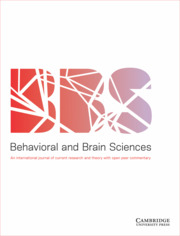Crossref Citations
This article has been cited by the following publications. This list is generated based on data provided by
Crossref.
Lacquaniti, Francesco
1992.
Automatic control of limb movement and posture.
Current Opinion in Neurobiology,
Vol. 2,
Issue. 6,
p.
807.
Hulliger, M.
1993.
Natural and Artificial Control of Hearing and Balance.
Vol. 97,
Issue. ,
p.
173.
Cavanagh, Peter R.
Simoneau, Guy G.
and
Ulbrecht, Jan S.
1993.
Ulceration, unsteadiness, and uncertainty: The biomechanical consequences of diabetes mellitus.
Journal of Biomechanics,
Vol. 26,
Issue. ,
p.
23.
Blaszczyk, JW
Hansen, PD
and
Lowe, DL
1993.
Accuracy of passive ankle joint positioning during quiet stance in young and elderly subjects.
Gait & Posture,
Vol. 1,
Issue. 4,
p.
211.
Requin, Jean
1994.
To dream is not to (intend to) do.
Behavioral and Brain Sciences,
Vol. 17,
Issue. 2,
p.
218.
Dufour, Robert
Fischer, Martin H.
and
Rosenbaum, David A.
1994.
Moving beyond imagination.
Behavioral and Brain Sciences,
Vol. 17,
Issue. 2,
p.
206.
Gandevia, S.C.
1994.
The sensation of effort co-varies with reflex effects on the motoneurone pool: Evidence and implications.
International Journal of Industrial Ergonomics,
Vol. 13,
Issue. 1,
p.
41.
Jeannerod, M.
1994.
The representing brain: Neural correlates of motor intention and imagery.
Behavioral and Brain Sciences,
Vol. 17,
Issue. 2,
p.
187.
Sinha, Chris
1994.
Canonical representations and constructive praxis: Some developmental and linguistic considerations.
Behavioral and Brain Sciences,
Vol. 17,
Issue. 2,
p.
223.
Pellizzer, Giuseppe
and
Georgopoulos, Apostolos P.
1994.
Representations of movement and representations in movement.
Behavioral and Brain Sciences,
Vol. 17,
Issue. 2,
p.
216.
Corcos, Daniel M.
1994.
Temporal representation in the control of movement.
Behavioral and Brain Sciences,
Vol. 17,
Issue. 2,
p.
206.
Skokowski, Paul G.
1994.
How do we satisfy our goals?.
Behavioral and Brain Sciences,
Vol. 17,
Issue. 2,
p.
224.
Milner, A. David
Carey, David P.
and
Harvey, Monika
1994.
Visually guided action and the “need to know”.
Behavioral and Brain Sciences,
Vol. 17,
Issue. 2,
p.
213.
Whiting, H. T. A.
and
Ingvaldsen, R. P.
1994.
The mystery-mastery-imagery complex.
Behavioral and Brain Sciences,
Vol. 17,
Issue. 2,
p.
228.
Redon, C.
Hay, L.
Rigal, R.
and
Roll, J.P.
1994.
Contribution of the propriomuscular channel to movement coding in children: A study involving the use of vibration-induced kinaesthetic illusion.
Human Movement Science,
Vol. 13,
Issue. 1,
p.
95.
Strong, Gary W.
1994.
Separability of reference frame distinctions from motor and visual images.
Behavioral and Brain Sciences,
Vol. 17,
Issue. 2,
p.
224.
Jeannerod, M.
1994.
Motor representations and reality.
Behavioral and Brain Sciences,
Vol. 17,
Issue. 2,
p.
229.
Fuster, Joaquin M.
1994.
Call it what it is: Motor memory.
Behavioral and Brain Sciences,
Vol. 17,
Issue. 2,
p.
208.
Walter, Charles B.
and
Swinnen, Stephan P.
1994.
Potential disparities between imagining and preparing motor skills.
Behavioral and Brain Sciences,
Vol. 17,
Issue. 2,
p.
227.
Roll, J. P.
Gilhodes, J. C.
and
Roll, R.
1994.
Kinaesthetic illusions as tools in understanding motor imagery.
Behavioral and Brain Sciences,
Vol. 17,
Issue. 2,
p.
220.


